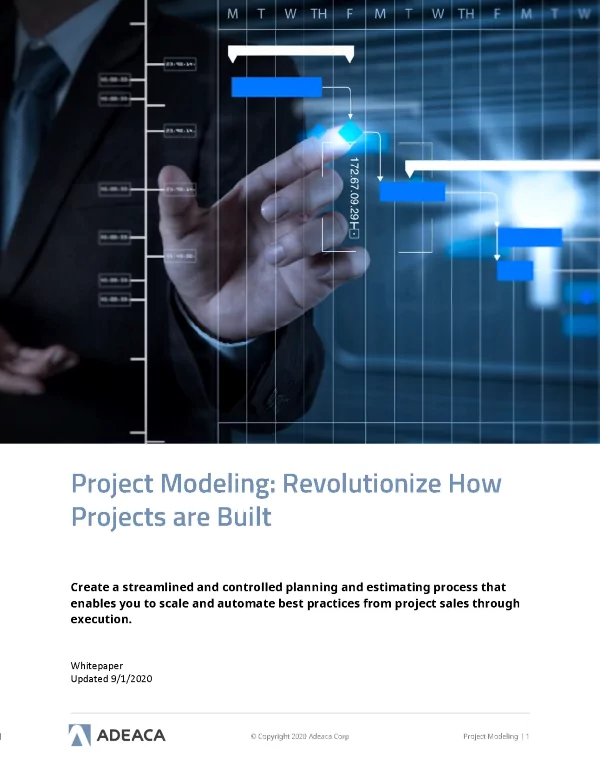When the successful delivery of projects is critical to your business, it’s critical to create optimal project schedules and financial estimates right from the start. Traditionally, salespeople and project managers have spent a lot of time and resources building complex projects, creating project proposals based on guesswork. Now, with a there’s an entirely new approach to the sales and initiation phase of a project that allows you to develop more accurate plans in less time, accelerate the sales process, and drive better outcomes for your customers.
As part of Adeaca Project Business Automation, Project Modeler creates a streamlined and controlled planning and estimating process that enables you to scale and automate best practices right from the start. By taking the specifications of a project template and making them variable inputs that allow any user to update easily, Project Models drastically increase the speed and accuracy of creating projects.
This capability is only possible with Adeaca PBA, a third generation, completely integrated project business solution that focuses on the business side of projects. Unlike generation one and two solutions, PBA seamlessly combines all project business areas including project financials, operations, and intelligence in one comprehensive business system.
Project Modeling: Dynamic Project Templates
Project Modeler takes project templates to a new level by making project templates dynamic. The specific quantities, types, and other specifications of a project template become variable inputs that a user can update before the model is inserted into the project. This means there are very few, if any changes required after the model generates the new project.
Project Models also provide an increased measure of process control. When using project templates, it’s easy to miss updating a specific task, which could have a significant effect on the project outcome. Project Models ask the user to specify every single variable before the project is created. This creases a repeatable process for building projects with best practices in mind and far less errors as a result. By using Project Models, you get a project plan with cost and price estimates that the user can trust.
Build More Accurate Sales Proposals Faster, Based on Real Project Data
Depending on the complexity of the project, oftentimes, building a project can take hours or even days as the project manager constructs each task and gathers information from different stakeholders to build the project plan and cost estimates. With Project Modeler, a user can configure an entire project in minutes through predefined components and rules. Cost and price estimates, schedules, and Gantt charts are created instantly after configuring and inserting a model into a project.
Strengthen Project Business Governance
Project models encapsulate and scale best practices across the company and from the beginning of the sales cycle. By using Project Modeler to build quotes and proposals, you create the optimal plan right from the start. When the plans presented in sales proposals are based on accurate models representing the best processes, the transition from sales to execution is seamless. This allows sales and operations to be aligned right from the beginning, guaranteeing the best possible plan is proposed and executed against. This reduces errors and changes as the project progresses.
Reduce Issues Later On
When you get it right from the start, there’s little issues that come up down the road. Oftentimes, project sales teams promise costs or schedules they think are reasonable at the time, but these expectations cannot be met by the execution team. With Project Modeler, sales teams are using models that represent accurate project work, so cost and schedules are achievable by the operations team.
Improve Collaboration
With Project Modeler, sales, planning, and operations teams work together seamlessly. As they build and transition plans, fewer changes are required, and the process becomes more fluid. Since each project utilizes standard components and processes, everyone understands and is familiar with how all projects work across the company. In addition, as new best practices or guidelines emerge, they are easily captured and shared through the central model library so companies can quickly adopt better processes and roll them out across the organization.
To learn more about Project Modeling, download the Project Modeling whitepaper.
A Generation 3 Project Business System is Required for Project Modeling
Since Project Modeling constructs a project’s financial and operational components at the same time, the model must have accurate, and up-to-date information to ensure the accuracy of the model’s output. If the cost, pricing, labor, procurement, and supply chain information lives in different systems such as the ERP, HR applications, estimating tools, or project management applications, by the time the data is gathered, it’s already outdated. Adeaca PBA brings the management of all financial, operational and intelligence data into one system that a Project Model can access in real time.











